I recently shared with you the experiences of my kitty Sunny’s spay day. Adrienna, one of my coworkers, was kind enough to provide us with pictures of her own little dog’s spay day and I figured I’d share this with you, our canine lovers!
Similar to Sunny’s experience, after the check-in process is complete, Lyra had her pre-surgical examination and her blood drawn to run a blood panel. We always stress having the bloodwork and pre-surgical examination performed as it allows us to minimize the risks associated with anesthetic. While we use the safest drugs available for any animal despite their age, we have room to adapt our anesthetic and the pain control protocol to suit our patient’s specific needs. Things like your pet’s heart rate, and if they happen to have a heart murmur can affect how we handle things. Sometimes our blood test results may even cause us to reschedule the surgery! If anything out of the ordinary did come up, it would be discussed with you by your veterinarian. Thankfully, in Lyra’s case, everything was normal! Lyra was cleared for surgery and was given an intramuscular injection to sedate her.
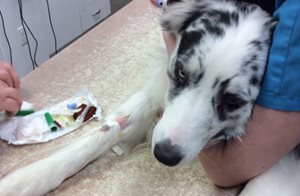
Once Lyra was sedated, we shaved her front leg and hooked her up to her IV fluids. Above is a picture of her with her fluids in her leg. You’ll notice next to her different swabs which we used to clean her leg before we hooked her up to her IV line. Fluid therapy is optional during our spay and neuter procedures for adult animals. It is not for our geriatric patients as they are not able to recover as quickly as a younger dog or cat. We always recommend fluid therapy for all of our surgical patients as they have several benefits. They allow us direct IV access during an emergency for quicker administration of life-saving drugs, fluids help maintain blood pressure, fluids maintain hydration, and they flush out the anesthetic and drugs from their system which makes for a speedier recovery.
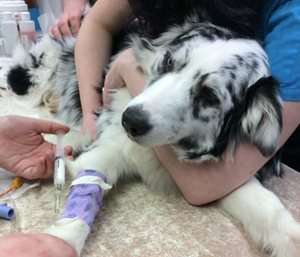
Lyra was then induced with an induction agent which made her sleepy enough to be intubated with a breathing tube. We induce our patients to make things safe for both them and us. I know I wouldn’t be comfortable with a breathing tube being inserted while I was awake!
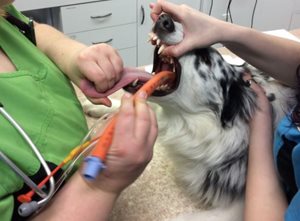
Heather, one of our RVTs, then carefully inserted Lyra’s breathing tube into Lyra’s windpipe to allow the anesthetic and oxygen to go directly into her lungs while she is under anesthetic. Heather, carefully moved Lyra’s tongue to the side to give her a good view of her windpipe while one of our Vet Assistants opened Lyra’s mouth.
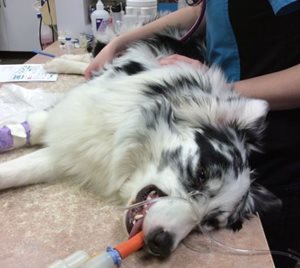
Once Lyra was intubated, the vet assistant taking care of her monitored her heart rate and respiratory rate with a stethoscope. Lyra would also have eye lubricant applied before we went ahead with shaving the surgical area and trimming her nails.
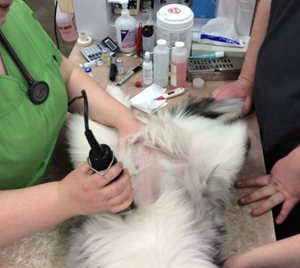
As pictured above, Heather carefully shaved the surgical site to ensure we can properly clean it before the incision is made. Unfortunately, we are unable to clean fur and prep it safely properly, so our pets do end up with a very different haircut when they come in for surgery.
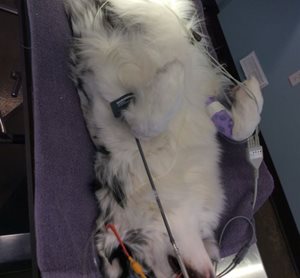
Lyra was then carried into our surgical suite where she was placed on a heated surface and hooked up to our electronic monitoring system. When we spay and/or neuter our dogs, we usually have the table angled in a v-shape to keep them in position during surgery. We keep our patients hooked up to an electronic monitoring system, but we also rely on our vet assistants to manually check our vitals throughout surgery. Technology is an amazing tool, but we also believe that we should double check the readings manually as well.
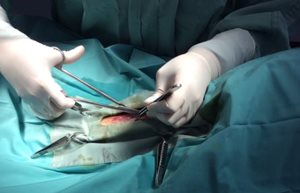
Once Lyra’s incision area was thoroughly cleaned, her veterinarian placed a surgical drape on top of her to maintain cleanliness and a sterile area for the incision. Above, Lyra’s incision area is being carefully cut open to access her ovaries. While this is happening, Lyra was being monitored by our vet assistants manually and electronically as well to ensure her vitals remained stable.
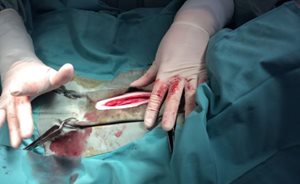
After Lyra’s ovaries were removed, her veterinarian prepared to close the incision. When closing an incision, our veterinarians will close each layer (linea, subcutaneous and skin) individually. We use internal dissolvable sutures for our spays and neuters which minimize the need for repeat visits so unless you’re concerned about something or your pet isn’t feeling well, you don’t need to come back after their spay/neuter appointment.
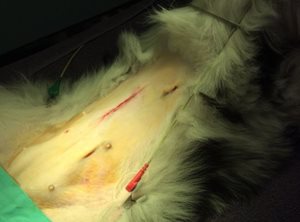
After Lyra was done surgery, her incision area was cleaned before she was moved into our recovery area. We keep our surgery patients in the recovery area for as long as necessary. During recovery Lyra had her temperature, mucous membrane refill rate, heart rate and respiratory rate checked periodically. Once Lyra was alert enough to be put back in her kennel, she was moved there to spend the rest of the day before she got to go home with Adrienna!
Written by: Marwa Al-Alawi, photos used with permission of Adrienna Taylor